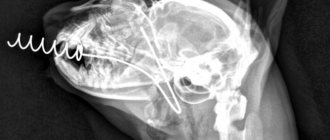Pets not only bring joy and variety to a person’s life. When problems arise with a pet's health, the owner often experiences anxiety and worry. Cats are a common type of domestic animal.
Many breeds do not require extensive grooming, and the owner's main job is to provide food. A cat's diet always contains fish and meat products. They may contain bones.
It is this part of the food that sometimes creates a big problem. Below in the article we will look at what to do if your cat has a bone stuck in its throat.
Symptoms and signs.
You can identify the problem by some of the symptoms and signs that the animal exhibits.
- The animal may cough constantly. This will continue until the bone comes out.
- The cat is breathing frequently and heavily. This symptom may also indicate other diseases, but if the pet ate fish or meat the day before, the cause may well be a bone.
- Vomiting. The cat will try to regurgitate the bone. Constant gagging indicates a stuck bone.
- Profuse salivation. The drool may hang directly from the mouth without the cat's mouth being tightly closed.
- The animal tries to pull out the bone on its own. In this case, the cat can move its paw along its face, as if trying to pull out a bone.
What are the dangers of fish intoxication?
- Poisoning from smoked, dried, salted, fried or raw fish often disrupts the functioning of organs and systems. A product contaminated with toxins can cause infectious-toxic shock.
- Due to bacterial intoxication, consciousness is often impaired, tachycardia develops, and blood pressure decreases. In severe cases, the poisoned person may fall into a coma.
- Dehydration develops due to excessive vomiting and diarrhea. Lack of fluid can cause internal organ failure and death.
- Acute renal failure occurs against the background of toxic shock. In severe cases, respiratory arrest occurs.
- Under the influence of toxic elements, acute gastritis and inflammation of the pancreas (pancreatitis) appear.
Particularly severe poisoning is caused by poisonous fish, such as fugu. Just 1 ml of toxin contained in the body of a pufferfish can kill an adult within 15–30 minutes. Intoxication is characterized by numbness of the mouth and limbs, incessant vomiting, and dysfunction of the diaphragm. This is a very dangerous condition that can lead to death.
When eating spoiled mackerel, tuna, saury and other fish of the mackerel or mackerel family, scombrotoxicosis often develops. The disease is usually caused by bacteria that begin to multiply when stored improperly. Moreover, even subsequent heat treatment does not prevent the appearance of scombrotoxins.
Symptoms of poisoning in this case develop within an hour. A tingling sensation appears in the mouth, itching of the skin begins, a rash appears, and a severe headache. Symptoms include rapid heartbeat, sweating, dizziness, as well as nausea and diarrhea. Such signs make intoxication similar to an allergic reaction.
Botulism poses a very serious danger. Respiratory paralysis, leading to respiratory arrest and death, can occur within two days. The causative agent of the disease, botulinum, develops in the absence of air. Therefore, it is believed that canned fish, pates, and hermetically packaged products should cause the greatest caution. However, you should remember to take precautions even if you eat a freshly prepared fish dish.
The Clostridium botulinum bacillus can penetrate fish tissue through wounds, including when caught with hooked gear. Doctor Suleizhan claims that “botulism poisoning is usually associated with the consumption of large fish” (Suleizhan B.Zh., 2011, p. 66). In the thickness of the tissues of a large individual there is also no access to air.
What to do if your cat has a bone stuck in its throat?
Naturally, the best solution is to go to a veterinary clinic. Almost every city has at least one 24-hour veterinary clinic. There is always a doctor on duty there. He will conduct an inspection and take the necessary measures.
Some people first try to remove the bone from the animal’s throat on their own. This is not always possible. The animal may show aggression and it will not be possible to examine it carefully. The cat may bite or scratch its owner. Therefore, it is better to immediately contact a specialist. Many people are interested in the question, what to do if a cat has a fish bone stuck in its throat?
False suffocation
The cat shits: what to do if the cat goes to the toilet anywhere
The above symptoms may not always mean getting stuck. Choking can occur due to other reasons:
- allergic reactions to household items, food;
- severe spasm of the larynx;
- the cat may have swallowed a hairball, which causes a gag reflex;
- the body's reaction to the drug used;
- difficult passage of food through the esophagus, when the cat must swallow large amounts of dry or other food;
- gag reflex due to pressure of food on the vault of the larynx.
Important! Any of the above conditions can be dangerous for a pet, since in the larynx the area of the respiratory and digestive tracts are located close to each other.
If your cat has a fish bone stuck
Despite the fact that the cat's jaw and mucous membranes are adapted to eating and chewing even large fish bones, there are times when the bone gets stuck in the throat. This is why veterinarians do not recommend giving domestic cats heads and tails from fish, as well as vertebral bones. They are the ones that most often get stuck in a cat's throat.
If such a problem arises, the animal will refuse to eat, cough, and try to pull out the foreign body with its paw. There is also regular gagging and excessive salivation.
In this case, you need to contact the nearest veterinary clinic. Specialists will help remove the bone from the throat and prescribe treatment if necessary.
X-ray
The main instrumental method for diagnosing a foreign body in the digestive tract is still an x-ray examination, carried out in at least two projections: ventro-dorsal (direct) and lateral (lateral).
The study can be carried out either with or without the use of a contrast agent. If the swallowed object is metallic, then it is most often radiopaque and clearly visible on the image. Stones and bones also have high radiological density. Even if the foreign body itself is not displayed on the image, some findings may indicate an appropriate diagnosis: “collected” intestinal loops, accumulation of gases in a certain area of the intestine may indicate its location.
If the foreign body is not radiopaque, a contrast agent is often used to determine the location of the obstruction. The animal is most often given barium sulfate or the more modern iodine-containing drug Omnipaque, and then a series of x-rays are taken at regular intervals.
In a healthy cat or dog, the liquid is evenly distributed in the lumen of the gastrointestinal tract and does not linger in any of the sections longer than necessary, and is then evacuated with feces. With obstruction, the solution stops or slows down its progress in the corresponding part of the digestive system, which is displayed in the image.
If a chicken bone is stuck
This is the most dangerous type of bone. In nature, cats often catch birds and eat them. Their jaws are capable of crunching hard bones and swallowing them. A domestic cat cannot always cope with such food. Therefore, many veterinarians do not recommend giving chicken bones to pets. Their fragments can get stuck in the throat or scratch it.
If a chicken bone gets stuck in a cat's throat, the animal will exhibit all the signs described above. To remove this residue from the throat, you must contact a veterinary clinic. The specialist will remove the bone from the throat and give recommendations on proper nutrition for the cat.
How to remove a bone from a cat's throat at home.
Many owners try to remove a stuck bone from a cat's throat on their own. If the animal does not show aggression, you can try to do this at home.
The first thing the owner does is try to feed the animal with bread crumbs or soft food. If after this the bone still bothers your pet, you can try to remove it with tweezers. This requires the participation of at least two people.
One should fix the cat's head and open its mouth. Many domestic cats allow their owners to do this. The second participant in the process must shine a flashlight into the pet’s throat and carefully examine it.
If the bone is clearly visible and accessible, you can remove it using tweezers. This must be done very carefully and hold your head tightly. If the animal tries to escape at this moment, the mucous membrane of the throat can be damaged.
The cat scratched its throat with a bone - what to do?
A bone doesn't always get stuck in a cat's throat. Passing into the esophagus, it can simply scratch the mucous membrane. The animal's behavior and symptoms are often similar to those of a bone stuck in the throat.
Only a specialist can make an accurate diagnosis. Even if the owner, opening the animal’s mouth wide, does not see the bone, this does not mean that it is not there. Only a veterinarian can accurately determine that the throat is scratched.
If he scratches his throat and doesn’t eat, what should I do? In this case, the animal may refuse food for a short period. The veterinarian may prescribe a throat treatment with furatsilin solution.
This can be done at home or visit a clinic. During the healing period, you can offer your pet soft food in the form of porridge, boiled rice, thick soup or soft food. The scratch does not bother the cat for long, and in a day or two the animal will begin to eat normally.
When do you need a veterinarian?
The help of a professional doctor is necessary in the following cases:
- complete lack of knowledge about first aid;
- bleeding from the esophagus, hemoptysis;
- a pregnant cat choked, a full analysis of its health should be performed, an ultrasound should be performed;
- lack of normalization of the pet’s health after removal of the foreign object.
Note! Often, several small fish bones may become stuck in the esophagus. A person will take out 1 of them, the other will remain inside. Therefore, it is better to make sure of its complete absence by conducting a complete diagnosis of the body.
How much does it cost to remove a bone from a cat's throat?
As a rule, this service in clinics is called something like this: “Removal of a foreign body from the pharynx, oral cavity, mouth.”
In Moscow, prices range from 500 to 1500 rubles. You may need to add the cost of the appointment to this, but this needs to be clarified with the chosen clinic.
Addresses of clinics in Moscow providing these services can be viewed at the link: https://zoon.ru/msk/m/izvlechenie_inorodnogo_tela_u_zhivotnogo/
We found information on the website of the Kursk clinic - price from 1100 rubles.
You need to call and check with each specific clinic.
This procedure may cost differently. The cost depends on the complexity of the operation. The price may be affected by the size of the animal, which affects the amount of anesthesia. Veterinary clinics often have a price list that indicates the average cost of such a service. However, it all depends on the specific case.
If a bone is stuck in a kitten's throat.
This option is the most common. It is kittens who most often choke on bones. Inexperienced owners want to accustom their baby to adult food as early as possible. This leads to the fact that the kitten does not chew well the bones that are too heavy for him, and they get stuck.
If a bone is stuck in your kitten's throat, you should immediately contact a veterinarian.
The baby is unlikely to cope with this problem on his own. It is not recommended to remove the bone yourself. The kitten's mucous membrane is still very delicate and can be damaged even more. Tweet
First aid
It is important that the owner immediately pays attention to the condition of the pet. You need to act according to the algorithm:
- Wrap the animal in a diaper or blanket to limit physical activity. Leave only your head free.
- Conduct a thorough examination of your pet's oral cavity. To look into his mouth, you need to carefully move the lower jaw down with the pressure of one finger.
- If a foreign object is visible, then you should try to pull it out using tweezers. It is not recommended to use your fingers in the cat's mouth. It is unlikely that you will be able to remove the bone in this way, but driving it much deeper and aggravating the situation is as easy as shelling pears.
To make the procedure more effective, it is better to involve an assistant in it.
Together, it is easier to fix the resisting “patient” and avoid possible injuries.
The bone is not in the throat. If a foreign object is not found in the pharynx, then further examination of the mouth should be abandoned. In this case, other actions are necessary to push it out:
- You need to confidently slap your pet on the back, choosing the area between the shoulder blades. The movement should be careful, but clear.
- You can quickly squeeze the cat's chest from the sides. The person needs to sit on the floor with the animal's croup facing him. The hind limbs should be raised and clamped with the knees. Place your hands on the cat's sides and squeeze the sternum to about 1/3 of its volume. You can’t fuss and push hard.
Such actions are aimed at provoking a cough, during which the cat itself can push out the bone that causes discomfort.











